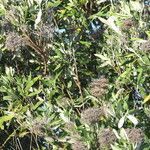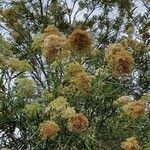Leaves decussate, those of a pair equal, often shortly petiolate: petiole lepidote, glabrescent, 1–20 mm. long; lamina subcoriaceous, narrowly elliptic to linear, variable in shape and size, 4–12 times as long as wide, 1·2–15 x 0·2–2(–3) cm. acute, acuminate, or less often rounded at the apex, cuneate at the base or decurrent into the petiole, entire or obscurely sinuate at the revolute margin, above lepidote–scaly when young, soon glabrous, much paler and densely grey– or tawny–pubescent with stellate hairs beneath; venation reticulate, impressed above, forming a line more or less parallel to the margin.
Shrub or small tree, 0.5-7.0 m high, branches closely leafy, ultimate twigs scaly, ± qaudrate, angles sometimes knobbled, ridged or winged. Leaves discolorous, petiolate, dark green, glabrescent, ± smooth above, light-coloured from dense, stellate scales beneath; blade linear, lanceolate or oblong, shortly or long acuminate at apex and base, rarely rounded, margins entire, revolute. Inflorescences terminal, in axils of upper leaves, large, many-flowered panicles. Flowers subsessile in 3-flowered cymes, small, ± 2 mm long, white or cream-coloured with reddish centre. Fruit a small, brown capsule.
Small tree or shrub, 0.5-7.0 m high. Leaves with blade linear to narrowly ovate, 15-100 x 2-15 mm, apex acute, base cuneate, margins entire, inrolled, upper surface glabrescent, veins impressed but distinct, lower surface light coloured, densely, stellately scaly, reticulate veins anastomose to form a line ± parallel to margins; petioles 2-10 mm long. Stipules represented by interpetiolar ridges, ridges faint or absent. Flowers: in many-flowered panicles; stamens clearly exserted; corolla ± 3 mm long, white, cream-coloured, cream-coloured with reddish centre; Oct.-May.
Corolla white or creamy, with erect lobes 1–8–2·2 times as long as the calyx, 1·8–3 mm. long, inside pilose with rather stiff hairs in the throat; tube cup–shaped or nearly so, mostly slightly shorter than the calyx, 0·5–1·2 x 0·7–1·2 mm.; lobes 1·2–2·5 times as long as the tube, suborbicular or elliptic, 1·1–5 times as long as wide, 1–1·8 x 0·8–1·2 mm., rounded, entire, recurved.
Small tree or shrub, 0.5-7.0 m high. Leaves petioled, long and narrow, smooth above, sometimes reticulate, margins entire. Stipules represented by interpetiolar ridges. Corolla tube short, campanulate. Anthers and filaments clearly exserted. Flowers white, cream, cream with reddish centre.
Pistil densely lepidote all over, 1–2 mm. long; ovary ovoid or nearly so, sometimes laterally compressed, 0·5–1·2 x 0·4–0·8 x 0·3–0·8 mm., 2–celled; style with stigma about as long as the ovary, 0·5–0·8 mm. long; each cell with one subcircular peltate placenta with 4–6 ovules outside.
Calyx cup–shaped or nearly so, 0·8–1·4 mm. long, outside densely lepidote–scaly; tube 0·7–4 x as long as the lobes; lobes equal or subequal, mostly broadly triangular, 0·5–1 times as long as wide, 0·2–0·6 x 0·4–0·6 mm., acute or obtuse, entire.
Shrub or tree, up to 7 m tall. Leaves petiolate, discolorous, lanceolate to narrowly elliptic. Flowers in velvety, paniculate cymes, cup-shaped with anthers exserted, cream-coloured with orange throat. Fruit an oblong capsule.
Stamens well–exserted; filaments 1–2·5 mm. long, inserted at or just above the middle of the corolla tube; anthers subcircular, 0·3–0·4 mm. long, glabrous; cells parallel or slightly divergent at the base.
Shrub or tree to 7 m. Leaves petiolate, discolorous, lanceolate. Flowers in velvety, paniculate cymes, cup-shaped with anthers exserted, cream-coloured with orange throat.
A small to medium sized tree. It keeps its leaves throughout the year. The trunk is short and crooked. The crown is dense and dome shaped. The leaves are greyish-green.
Capsule oblong, often laterally, compressed, 1·5–2·5 x 0·8–1·2 x 0·8–1 mm., sparsely lepidote, about twice as long as the calyx, 2 (later 4–)valved.
Inflorescence terminal and often also in the axils of the upper leaves, paniculate, large, many–flowered, lax or rather so, 3 x 3 to 18 x 16 cm.
Seeds medium brown, obliquely tetrahedral or nearly fusiform, 0·9–1·3 x 0·4–0·6 x 0·2–0·4 mm., obscurely winged or not, minutely reticulate.
Branchlets terete or quadrangular and with 4 ridges or narrow wings, lepidote especially at the apex.
Flowers subsessile in 3–flowered cymes, sweet–scented.
Shrub or small tree, 0·5–12 m. high, much branched.





